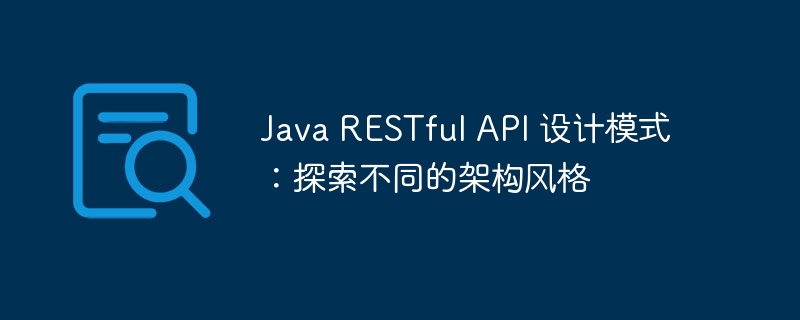Java RESTful API 設計模式:探索不同的架構風格
- WBOYWBOYWBOYWBOYWBOYWBOYWBOYWBOYWBOYWBOYWBOYWBOYWB轉載
- 2024-03-09 09:31:11921瀏覽

Java RESTful API 設計模式是現代軟體開發中至關重要的一環。在這篇文章中,php小編草莓將帶領大家探索不同的架構風格,深入了解RESTful API設計的關鍵概念與最佳實務。無論您是初學者還是經驗豐富的開發人員,本文都將為您揭示如何透過合理的設計模式來建立高效、可維護的RESTful API,為您的專案增添更多優勢。
1. RESTful 資源
RESTful 資源是 API 的核心組成部分。它們表示應用程式中感興趣的實體,例如客戶、產品或訂單。資源使用 URI 標識,並且可以透過 Http 方法(GET、POST、PUT、DELETE)進行操作。
@Entity
public class Customer {
@Id
@GeneratedValue(strategy=GenerationType.AUTO)
private Long id;
private String name;
private String email;
// ...
}
2. 超媒體
#超媒體 API 提供額外的信息,例如可用操作的連結、格式規格和相關的資源。這使得客戶端能夠動態地瀏覽和互動 API,而無需事先了解其所有端點。
@GetMapping(produces = {MediaType.APPLICATION_HAL_JSON_VALUE})
public ResponseEntity<Resource<Customer>> getCustomer(@PathVariable Long id) {
Customer customer = customerService.findById(id);
Resource<Customer> resource = new Resource<>(customer);
resource.add(linkTo(methodOn(CustomerController.class).getCustomer(id)).withSelfRel());
resource.add(linkTo(methodOn(CustomerController.class).getAllCustomers()).withRel("customers"));
return ResponseEntity.ok(resource);
}
3. HATEOAS
HATEOAS(超文本作為應用程式狀態引擎)是一種 RESTful 架構模式,它使用超媒體讓客戶端了解可用操作和資源。透過將狀態嵌入到 API 回應中,HATEOAS 消除了對文件的需要,並促進了 API 的可發現性。
@GetMapping(produces = {MediaType.APPLICATION_HAL_jsON_VALUE})
public ResponseEntity<Resource<Customer>> getCustomer(@PathVariable Long id) {
Customer customer = customerService.findById(id);
Resource<Customer> resource = new Resource<>(customer);
resource.add(linkTo(methodOn(CustomerController.class).getCustomer(id)).withSelfRel());
resource.add(linkTo(methodOn(CustomerController.class).getAllCustomers()).withRel("customers"));
resource.add(linkTo(methodOn(CustomerController.class).updateCustomer(id, null)).withRel("update"));
resource.add(linkTo(methodOn(CustomerController.class).deleteCustomer(id)).withRel("delete"));
return ResponseEntity.ok(resource);
}
4. 微服務
#微服務是一種架構風格,其中應用程式被分解為鬆散耦合的小服務。每個微服務負責一個特定功能,並透過 API 與其他服務進行通訊。這種模式提高了可擴充性、靈活性,並且還簡化了維護和部署。
@SpringBootApplication
public class CustomerMicroserviceApplication {
public static void main(String[] args) {
springApplication.run(CustomerMicroserviceApplication.class, args);
}
}
@RestController
@RequestMapping("/api/customers")
public class CustomerController {
@Autowired
private CustomerService customerService;
@GetMapping
public List<Customer> getAllCustomers() {
return customerService.findAll();
}
@GetMapping("/{id}")
public Customer getCustomer(@PathVariable Long id) {
return customerService.findById(id);
}
@PostMapping
public Customer createCustomer(@RequestBody Customer customer) {
return customerService.save(customer);
}
@PutMapping("/{id}")
public Customer updateCustomer(@PathVariable Long id, @RequestBody Customer customer) {
return customerService.update(id, customer);
}
@DeleteMapping("/{id}")
public void deleteCustomer(@PathVariable Long id) {
customerService.delete(id);
}
}
選擇最佳模式
#選擇合適的 RESTful API 設計模式取決於應用程式的特定要求。對於簡單且靜態的 API,RESTful 資源模型就足夠了。對於更複雜的 API,超媒體或 HATEOAS 可以提供更好的可發現性。微服務模式適用於需要可擴充性和靈活性的大型應用程式。
結論
RESTful API 的設計模式提供了指導,幫助開發人員創建高效、可維護且可擴展的 API。透過了解不同的架構風格,您可以選擇最適合您應用程式需求的模式,從而實現更好的 API 設計和互動。
以上是Java RESTful API 設計模式:探索不同的架構風格的詳細內容。更多資訊請關注PHP中文網其他相關文章!

